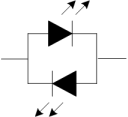Bi-Colour LED
There are two different types of bicolour LEDs. In my terminology, I call this one bi-colour, and the other tri-colour.
A bi-colour LED is a single LED package with two LEDs inside, installed in a loop. The component will have two legs, and will have a clear or frosted lens (plastic bit).

If current flows in one direction, one LED will light. If the current is reversed, the other LED will light. If no current flows, then obviously no LEDs will light. Both LEDs cannot be lit at the same time. The HID device will represent this LED as an output with 3 states - 0=off, 1=LED1 on, 2=LED3 on. A bi-colour LED can be connected to any I/O port.
The datasheet for this type of LED should have values for VF and IF for both LEDs. The current limiting resistor is shared between the two LEDs, so a value must be chosen not to exceed the limit on either LEDs. The bi-colour LED is connected to two microcontroller pins. Don't forget the current limiting resistor.

Properties
Name
Components can be given an optional name. This is seen in the Test tab. Not all applications support the name. Hidcomp/hidconfig supports names.
UsagePage/Usage
The UsagePage and Usage of the LED. See Usages for more information.
Current
Defines the amount of electrical current used by the LED in mA. This is used to estimate the USB power draw. See the section on Power for more information.